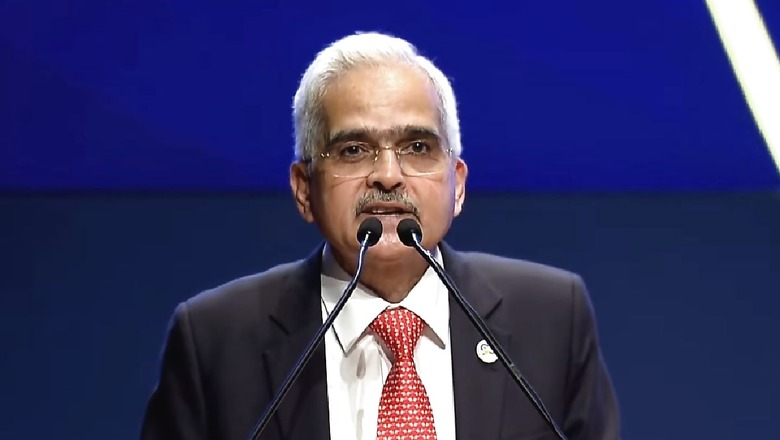
views
Reserve Bank Governor Shaktikanta Das on Wednesday said the central bank is focused on making the UPI and RuPay ‘truly global’ and asked financial institutions and fintech startups to adapt robust frameworks to capitalise on the new opportunities while mitigating connected risks.
Speaking at the Global Fintech Fest 2024, the governor said digital financial inclusion, digital public infrastructure (DPI), consumer protection and cyber security, sustainable finance, and global integration and cooperation are the five priority areas for the Reserve Bank.
Das said strengthening financial infrastructure, including cross-border payment systems, will be key focus areas as India, with its tech talent and evolved fintech ecosystem, holds the potential to serve as a global hub for digital innovation and fintech startups.
Building and strengthening strategic partnerships, reinforcing the commitment to international cooperation, and developing institutions of excellence in the areas of technology and innovation across a wide spectrum of areas, including financial services, would give the right impetus for our journey towards 2047, he added.
“Based on the encouraging response we have received from several jurisdictions, we are now focusing on making the UPI and RuPay truly global,” Das said.
Unified Payments Interface (UPI) is an instant real-time payment system to facilitate inter-bank transactions through mobile phones, while RuPay is a domestically designed global card payment network.
India’s CBDC, which is in the pilot stage, is another example of possible international cooperation, Das said, adding that the RBI is now utilising features like programmability to provide credit or government assistance to landless tenant farmers and carbon credits to farmers through CBDC.
“While we have successfully demonstrated the interoperability of CBDC with retail fast payment systems like UPI, we continue to gain from our experimentation on off-line solutions. As we make progress, we would be happy to cooperate with other nations in their CBDC efforts,” the governor said.
Das also touched upon the regulatory approach for the fintech sector.
“Sustainable and orderly development of the fintech sector requires an appropriate balance between innovation and prudence. Our endeavour is to carefully craft regulations to achieve this delicate balance, while simultaneously ensuring trust, security, accessibility, risk management and competition,” he said.
Emphasising that developing a mindset that anticipates disruption and embraces change with prudence becomes very important, Das said, “Financial institutions and FinTech startups alike must, therefore, adapt swiftly, leveraging agile strategies and robust frameworks to capitalise on the new opportunities while mitigating the connected risks”.
Publicly available information places the number of FinTechs founded in India at approximately eleven thousand (11,000).
The sector has received investments of about USD 6 billion in the last two years alone, Das said.
He further said a preferred approach for achieving balance between innovation and prudent regulation involves self-regulation within the fintech sector.
Self-regulatory organisations (SROs), comprising industry participants and having a good understanding of the sector’s unique challenges and opportunities, would be in a position to give appropriate suggestions to the regulators on regulations that are both practical and effective.
The RBI has received 3 applications for recognition as a Self-Regulatory Organisation(s) in the FinTech Sector (SRO-FT).
The central bank has decided to recognise the Fintech Association for Consumer Empowerment (FACE) as an SRO-FT.
“Of the remaining two applications, one application has been returned with a provision for resubmission after meeting certain requirements. The third application is under examination,” Das added.
On digital financial inclusion, the governor said as a policy priority, financial inclusion should ensure that everyone has appropriate access to financial services.
Digital financial inclusion has the unique advantages of scalability and cost-effectiveness, he added.
Accordingly, the next two decades will predominantly be about leveraging technology to deliver accessible and tailored financial services that meet diverse needs, he said.
Talking about the RBI’s priority on digital public infrastructure, Das said one significant initiative in this direction is the Reserve Bank’s pilot on Unified Lending Interface (ULI), earlier known as Public Tech Platform for Frictionless Credit (PTPFC).
ULI aims to enable lending institutions to offer frictionless, end-to-end digital credit by leveraging consent-based data and related services.
There are about 50 such types of data services on the platform, apart from banks and NBFCs. The RBI is now focusing on the inclusion of other lenders like cooperative credit institutions through the NABARD.
“A full-scale launch of ULI will be done in due course. As I said two days ago in another event, the ‘New Trinity’ of JAM-UPI-ULI will mark a revolutionary step forward in India’s DPI journey,” Das said.




















Comments
0 comment